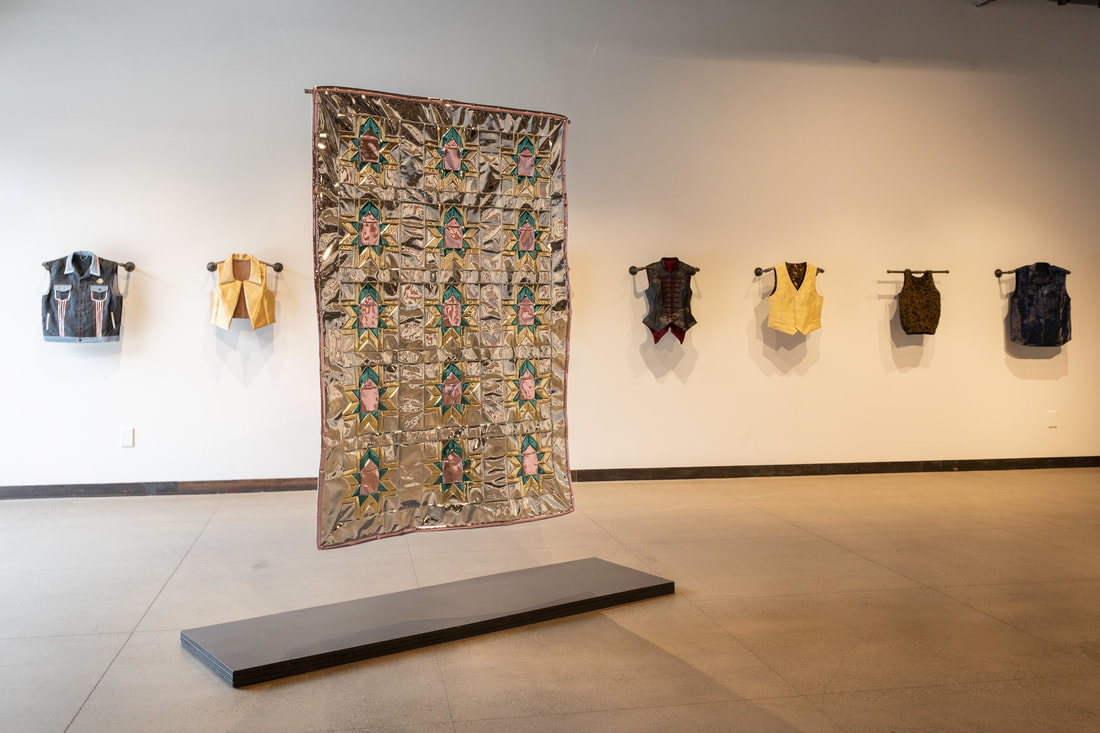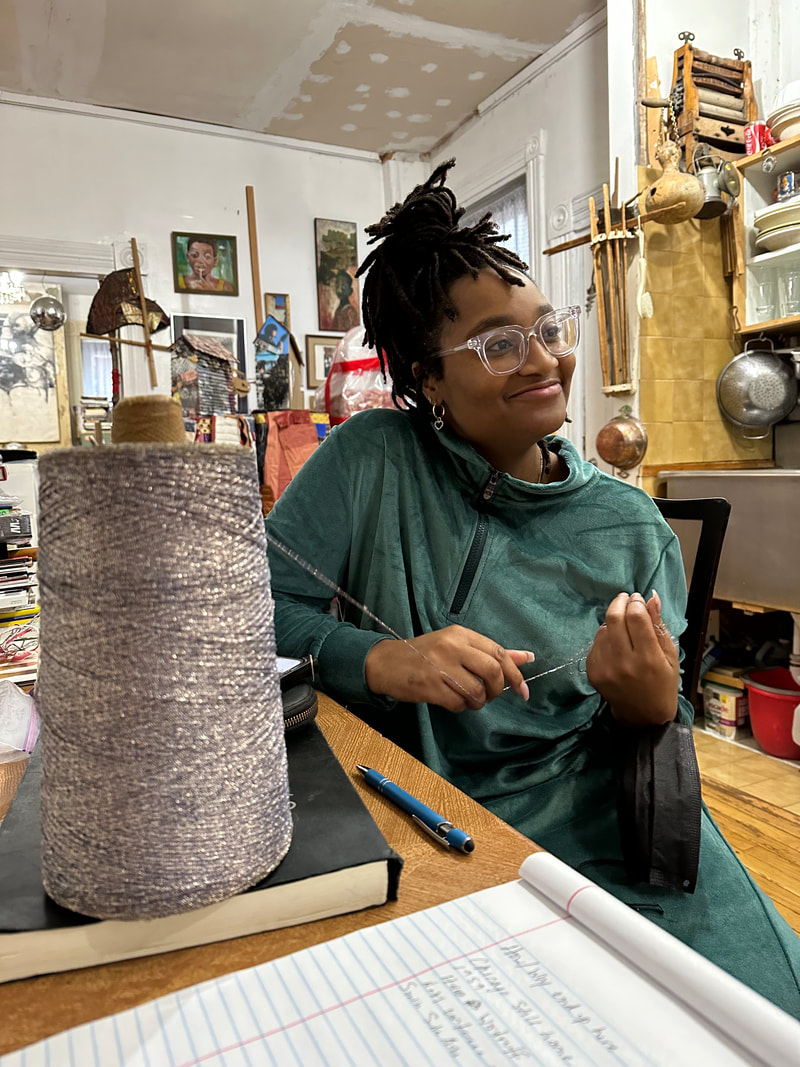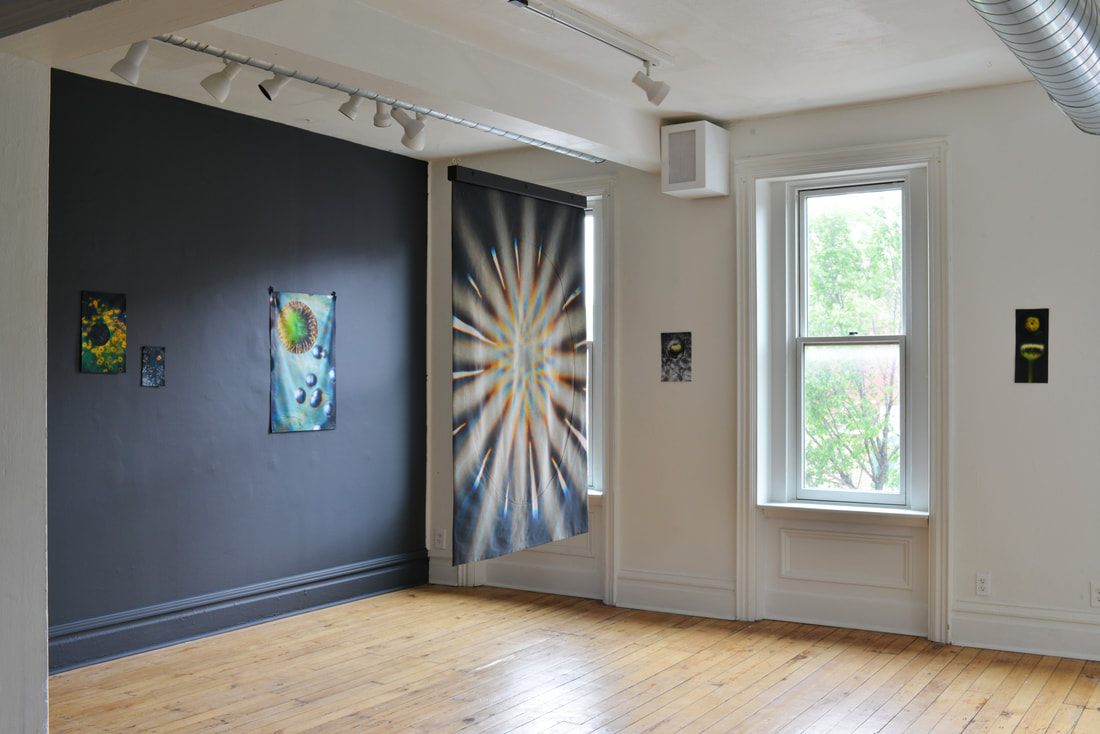7/8/2022 Edited by Harrison Kinnane Smith

The views and opinions expressed in this article are solely those of the author. They do not reflect the opinions or views of Bunker Projects or its members.
In this conversation between Bunker Projects resident and former Bunker board member Fred and Bunker alumnus Eric Anthony Berdis, the artists discuss how Berdis’ visual art and social practice work is informed by their teaching, childhood experiences, and a desire to celebrate the “ghosts” of queer history. Keep scrolling after the interview for Blauth’s poem “How to make a Paper Ghost (child’s poem),” authored in response to Berdis’ current exhibition at Bunker, Couldn’t keep the flowers alive.
Fred: Thinking about you working here in Pittsburgh, back in your childhood home, makes me think about the narratives and stories that happen in your work. You know, you’re in these spaces. These are your people who you’re interacting with. This is your environment… What times are you thinking about in your work with your narratives? Do you find that you’re working with memories from a really far distant past, or from the current time you live in right now?
Eric Anthony Berdis: Well, in the early work, there’s like a masked superhero character. I was responding to, you know, me being a queer teacher, being 22 and trying to make work. That was my first live performance. And it was, you know, very jarring. People were like, “Oh my God, he’s gonna really eat all those bananas.” And it was raw and I was obviously exposing a lot of myself being in my underwear, vulnerable, and doing some of the cliches performance art has that I think in this instance are hyper campy.
I rode this hobbyhorse around the gallery as, like, my superhero character. And there was poem I said: “I just want to let you know when you use the word faggot it creates an unsafe space for people that identify as gay, lesbian, transgender, queer, and I’m gonna ask you don’t use that word around me anymore. Thank you.” And then I ate the bananas and repeatedly just kept saying it while eating the bananas. It was a lot for a lot of viewers.
F: Did you write that yourself?
EAB: I used an adapted version of that for when I spoke to students that would use that language in my classroom.
F: Oh my god. Wow. So that’s already connected to your teaching. And day one, you’re thinking about how to communicate with children, how to be queer as a child, how to grow up queer. How to talk to people.
EAB: I will say a lot of things in my work were kind of coming together. Obviously I wasn’t going into schools dressed as this. I was going to sub at schools dressed like myself, as a person, you know, and thinking of ways this superhero could come out, even though he didn’t have the mask on or wasn’t in his costume. I have been building this world for this character to live in and to experience, you know. Partially thinking of myself, as a child, as a queer person, as a queer youth who’s now way more comfortable in myself. But at the time, when I heard the word faggot, I was like, you know, needing therapy.
F: Yeah, it cuts, it fucking cuts.
EAB: And so that really kickstarted the world-building part of my practice that I think I’ve been working towards and experimenting with since my first time at Bunker. I think the exhibition that I was working on was like an initial try. It was also my first residency. I think the 2018 show was successful in certain ways and I grew and I thought about a lot of things. But the work that I made there, in those four months, doesn’t hold a candle to the amount of stuff I have in this show.
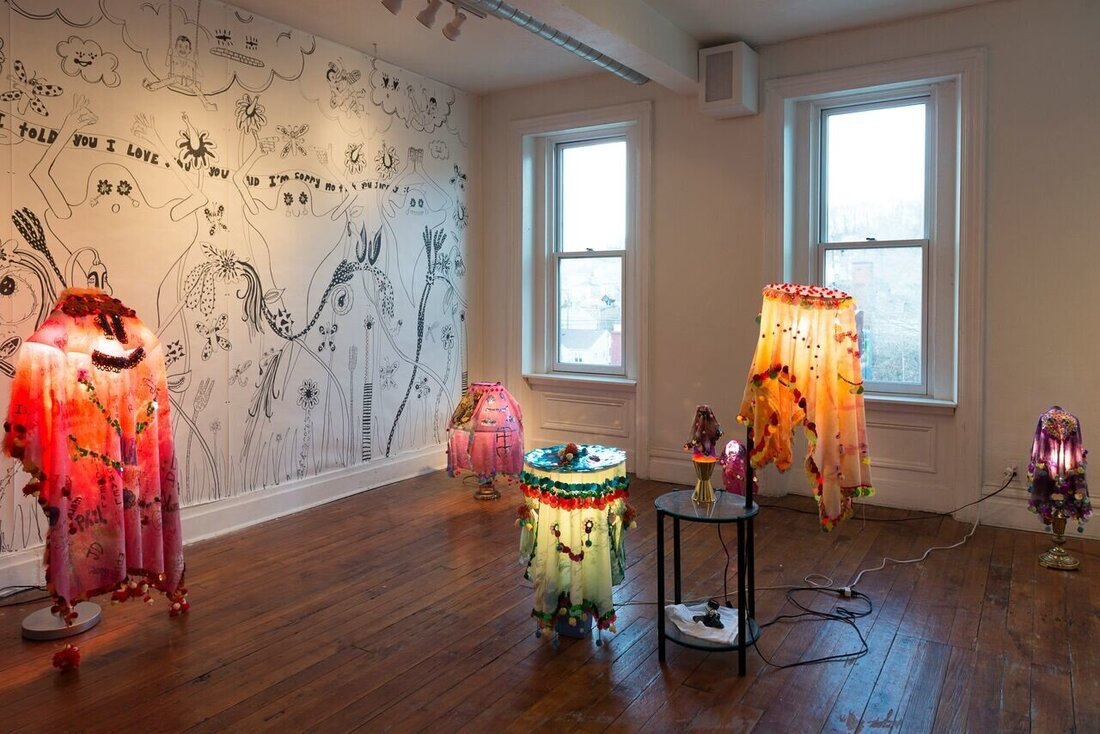
Installation view of Eric Anthony Berdis’ work in The Ghost of You is What Haunts Me (2018) at Bunker Projects.
EAB: I think one of your questions was like, “how do you get some of your imagery?’ The smiley face is like a very poignant image in a lot of my work. It’s a very obviously cliche thing… when I was little, I’d say, “they’re calling me gay at school.” And my mom’s like, “oh, that just means you’re happy.” But that’s not what they mean. Like, I know what you’re saying, mom. But they don’t mean that. So I was thinking, I’m kind of taking these very queer historical things and then turning them back into these childhood activities, or romance.
In that show, I just wanted to see what the gayest smile can look like. What happens when you have all these things smiling back at you? And so a lot of times, you won’t just see one smiley face, you’ll see 17 or 18. There’s this hauntedness that comes out when you’re looking at 1000 faces.
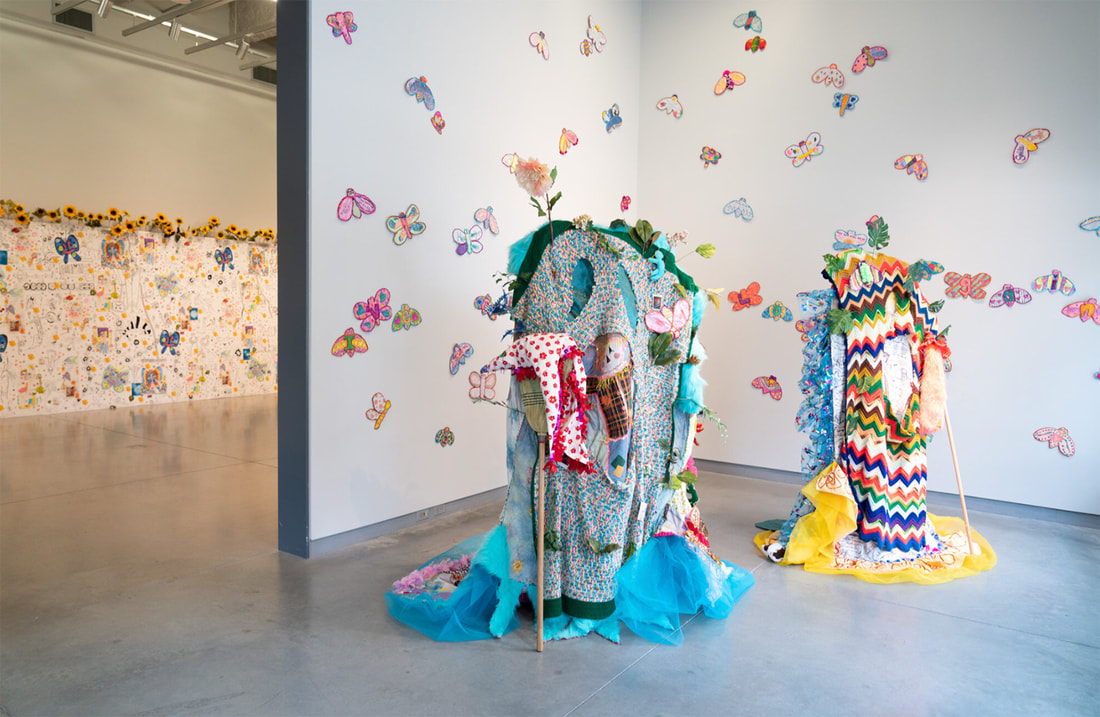
Installation view of Eric Anthony Berdis’ Don’t Let Them Clip Your Tiny Little Insect Wings (2019) at University Galleries, Illinois State University, Normal-Bloomington, IL.
EAB: I was invited to exhibit by Jessica Bingham, who was the curator at Illinois State University, in response to their Safe Zone training that was started the year Matthew Shepard was murdered. Matthew Shepard was a young man going to college and was walking home in Wyoming and was gay bashed and murdered. That was in Wyoming. Wyoming and Illinois are, you know, not like urban metropolises. They’re mostly small towns. So in Illinois they saw a lot of similarities — similar attacks happening in their town and at their university. And so they started Safe Zone training, kind of in a fear-mongering way. They were like, “I don’t want this to happen. We don’t want this to happen here. So how can we change that?” And I think Brandon Teena’s death was another story that was already well publicized in media. The film adaptation of Teena’s story, Boys Don’t Cry came out that same year.
F: When did all this happen?
EAB: This was in 1999. So they were celebrating their 20 years of progressive Safe Zone training and queer representation for Pride Month, and they invited me to have this exhibition. So I was reflecting on queer history and ghosts and realized “Oh, this legacy of Matthew Shepard is really poignant. Yes, we know the AIDS crisis. Yes, there are all of these things in history, but also people my age have been killed. You know, people our age have been killed, or bullied to death so much that they’re, you know, killing themselves for being gay. And now I think about all the trans youth that are just getting murdered. So I think even though this work started referencing these queer performance artists, I have been thinking of ways to honor these other deaths that have happened, and I’m still figuring that out. This show was one way of thinking about that, and pulling imagery. I did not want the exhibition just to be about death and dying, and these sad, really hyper-sad spaces.
F: Almost like Day of the Dead, where it’s a celebration in connection with the past and across time.
EAB: Completely. So I invited young children, adults, anyone who would want to participate, and had them make bugs, which ended up on the ghosts and all around the gallery. They were a kind of community engagement project that I did, working with, you know, schools and communities and just talking to them about my work and saying “here’s one way that you could be a part of this.” I had them reflect on a time that they felt squashed like a bug, and what that they said to themselves to give them wings to keep going. Then they created these bugs that were just marker and puffy paint and pom poms and glue. Later, I went back and quilted them all, and embellished around them. Kind of in an act of care, and also a way to finish them, so they would be nicely presented in the gallery. And so in this part of the exhibition you see all these ghosts referencing death and stuff, but there’s also all these community voices of saying like trans lives matter Black Lives Matter, you care. It was just a very positive and light and bright project.
Installation view of Eric Anthony Berdis’ Couldn’t keep the flowers alive (2022) at Bunker Projects.
EAB: I will say, the ghosts that are in this current show at Bunker are all new ghosts. I knew I wanted to make new pieces for this show. I’d been getting better at quilting, no denying that. And I’m getting better at sewing. After my 2 years of grad school where I had to build my craft. So I started with quilting the panels, like making a blanket. And then I MacGyver an armature that will stand, and hold the blankets. From there I assemble, taking them off, adding more to the quilts, testing it out again, iterating.
F: In residence at the Bunker studios I loved living with these things. It felt like they were friends that I’d walk by everyday. The scale is right.
…
EAB: You mentioned something about fashion. I saw a Patrick Kelly show at the Philadelphia Museum of Art. He was a fashion designer and hyper-camp in his use of buttons, etc. He used that icon of the blackface mammy character. Obviously I’m not pulling things from there, but I am invested in how he curated this iconography and signature in his practice through fashion with clashing prints and hilarious campy moments. If you ever watch a runway walk from his shows, you’ll see they’re so joyful and amazing. So seeing his work was really revolutionary in my approaches to making and crafting items. He did a lot of experimentation.
You know, he’s another ghost in our community who died of AIDS. When I first moved to Philadelphia, I had no money. And so I was going to like the museums’ free nights, and I went to the show probably about 17 times. He was one that I’m you know, in love with. I think about his practice a lot, his use of text with the fabric and in the buttons

Installation view of Eric Anthony Berdis’ Couldn’t keep the flowers alive (2022) at Bunker Projects.
EAB: There’s this portrait of Felix Partz I think about every day.
F: It’s so haunting to me too.
EAB: And, you know, it’s often shown billboard size. AA Bronson’s portrait of Felix Partz is of his death, but he’s surrounded in this color, this bright warm fabric, and care and love… his tape recorder and remote. The sagging of the fabric draped on to the thing felt similar to the portrait of Felix Partz, because he’s not smiling. His face is sagging because its life has left him. His cheeks are beginning to droop and his eyes are very sunken in. The ghost became alive. When I draped the fabric over with the cutouts and armatures, the smiley face became a scream.
F: We’ve already seen all of these through lines to the ghosts to the death to the afterlife, you know, it makes sense that you’re so interested in this post mortem photo, surrounded by all of this fabric, you know, that’s handmade. The color scheme has immense impact. It’s amazing. Only that person could have come up with that. Just like your blankets, your ghosts. Only you could have done or made them.
How to make a Paper Ghost (child’s poem)
by Fred
Mr. B’s ghosts do not frighten me, they give me a good feeling
They must have had a jolly time when they were living
Covered in stripes, polka-dots and jewels that sparkle and swirl
Mr. B’s ghosts love to dance and twirl!
But what’s beneath those amazing outfits?
Secrets under those beautiful blankets.
* * *
The afterlife sure is long, they must have brought their favorite things along!
A comfy chair? Some pillows? And lots of snacks? Books to read and blocks to stack?
Grab your favorite things from around the house
and don’t forget towels, sheets and that special blouse
Maybe some cups and pots too from the kitchen,
But only with mom and dad’s permission!
Can you make a stack as tall as you?
Or will you make a mini friend or two?
There’s no right or wrong way to do it,
I just know you can figure it out, Boo!
* * *
Once your pile is built and you’re sure its steady,
our ghosts are almost ready!
Gather your fabric and ask a buddy to help cover
But be careful! You don’t want to knock anything over!
You did it! Hooray! Its better than I could have dreamed of
Your ghost is made up of all the things you love!
New time you see one, you won’t be afraid
Now you know what ghosts are made of, and you will be brave!
Eric Anthony Berdis (Erie, PA) also known as Mr. B, is an artist, elementary school teacher, and second-time resident at Bunker Project (alum 2018). Eric’s practice strives to celebrate DIY collectivity, and play for not only themselves but his students. Eric received his MFA from Virginia Commonwealth University. He has had solo exhibitions at the University Galleries of Illinois State University, Project 1612 (Peoria IL), and Practice Gallery (Philadelphia) They have exhibited work at Iridian Gallery (Richmond VA), Stay Home Gallery, (Paris TN), Oklahomo (Chicago), and the Erie Art Museum. His work has been published in Hiss Mag, Emergency Index, and New American Painting.
Fred used to live in Pittsburgh on Negley Ave in an apartment with a spiral staircase, but now lives in Woodside, Queens with his 20 year-old cat, Kero. Before the pandemic, he was an arts worker, writer and curator (and a lifeguard, bellhop and bakery delivery driver too). He takes fencing lessons, plays bingo at least once a month and has made thousands of hand-cut stickers, hundreds of paper bracelets, three swimsuits (one is lost!), and concocted his own sprinkle recipe. He wants to make ribbon wands next and finish the two quilts he started. He likes to make things and give them away right now.
Eric Anthony Berdis’ Couldnt keep the flowers alive is on display at Bunker Projects through July 15, 2022.
